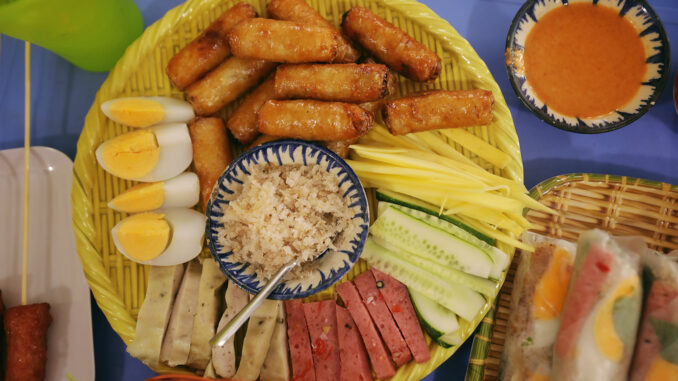
BINH THUAN – During the journey to discover Phan Thiet cuisine, Ha Manh heard stories about Quang duck noodles, one-day squid, and herring rolls.
Ha Manh, born in 1991, currently living and working in Ho Chi Minh City, is working on a documentary project about culinary experiences across Vietnam. The film follows Manh’s footsteps walking across the country on the North-South railway, randomly getting off at stations along the way, eating and chatting with the people who make the specialties. The project was named by him “Going to eat alone” because his life in Ho Chi Minh City was alone. During meals when no one is around, he often watches a movie about food to reduce the feeling of loneliness.
Phan Thiet city in the minds of many people is a dry place, with hot weather and full of sand dunes. Therefore, this is not a popular tourist destination until 1995, a total solar eclipse occurred with the ideal viewing point being this land. People are more interested in the beautiful scenery of Phan Thiet such as white sand, and blue sea and of course attracted by many street foods.

The first dish is Quang duck noodles at A Gioi breakfast restaurant on Hung Vuong Avenue. The shop is always busy with customers coming in and out in the early morning, is one of the names that make Quang duck noodles only available in Phan Thiet. The shop owner is Ms. Bay, 37 years old, who used to be an accountant working in Ho Chi Minh City before returning to her hometown to restore her mother’s burden of Quang noodles on the sidewalk. After many years of preservation and development, now Quang noodles of Ms. Bay’s family have become a big brand not only for locals but also for tourists.
Coming to Phan Thiet but eating Quang Nam specialties is something that many people wonder about, but Quang noodles with duck meat are not everywhere. Initially, the shop was called Anh Gioi (Goi is the name of Bay’s father) but because she wanted the name “chou” more, Ms. Bay changed it to A Gioi to attract customers. Every weekday, Ms. Bay makes 12 kg of pork (pork sausages, ribs) and on weekends, 15 kg to boil water. She said, to be suitable for tourists, she has to cook less sweet because tourists from all over the world come to Phan Thiet to play or jokingly call Quang noodles here “tea” because it’s too sweet.



Herring rolls are the second dish that Manh learns about. Dung rolls brand has been around for more than 40 years in Phan Thiet. The dish uses two locally available ingredients, herring picked up from the harbor every morning, and cassava roots (legumes) combined to create a signature dish that spans three generations. Hang – who is in charge of the shop’s activities, continues to inherit and improve the recipe left by her grandmother. As she recounted, her grandmother is the one who invented and sold the herring rolls here.
To make a large quantity, the restaurant needs about 10-12 people for preparation, cooking and helping. Ms. Hang is proud of the restaurant’s peanut sauce. “The dipping sauce is made from pure peanuts, the taste of which many people praise, can’t be found anywhere other than my family.” As for Ha Manh herself, she praised the herring rolls, saying that this is an “above excellent” afternoon snack.

Then, Manh met a third character, a woman in her 50s who witnessed the change in Phan Thiet’s skin after the total solar eclipse in 1995. That was Ms. Loan, the owner of Cay Bang restaurant, restaurant. The only one is located close to Ong Dia rock. She is the one who found out how to process squid leaves, an unpopular ink that has become a specialty of Phan Thiet.
“In 1996, people only liked two types of squid. Squid to make dried squid, cuttlefish to stir-fry. Why isn’t squid delicious?”, Ms. Loan shared. Fishermen at that time told her that when eaten fresh, squid leaves are crispy while most people like to eat soft, and when eaten dry, squid leaves are hard. Listening to opinions, Ms. Loan thought of a way to make squid so that it was both dry and fresh, with the right crunch and softness, and decided to let it dry for one day. According to her, this may have become the secret to making squid ink which is famous throughout Vietnam today.

After the trip, Ha Manh was surprised at how arid Phan Thiet land creates specialties. All are simple, and ingredients are easy to find and available, but through the hands of dedicated chefs, they have their own unique and attractive taste.
Photo: Internet
